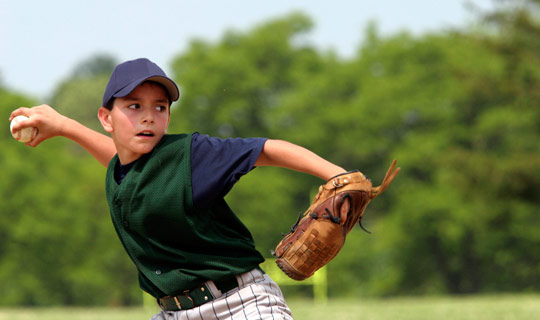
As spring arrives many baseball players are gearing up for America’s favorite past time. Unfortunately, injuries are on the rise, with shoulder and elbow injuries often the culprit for many missed games, even missed seasons. Many of these injuries can be avoided by spending just a few minutes a week doing some simple exercises.
There are several different exercise programs used by teams which focus on using bands to strengthening the throwing arm. Most of these programs focus on internal rotation and external rotation of the shoulder, and on the muscles meant to stabilize the shoulder during throwing. They can be performed throughout the season, as the key focus of these exercises is not to develop size of the muscle, but to build endurance of the involved muscles. Remember that throwing is a repetitive activity!
Often overlooked when talking about elbow and shoulder injuries is the importance of adequate thoracic mobility and core strength. Thoracic mobility pertains to range of motion in the upper back, ribcage, and shoulder blades. Since throwing requires many different movements, using proper throwing mechanics is important. While an arm appears to be doing the majority of the motion, the body is also rotating. Limited thoracic extension can significantly limit your shoulder’s ability to fully move through your range of motion. This can lead to overuse or compensation, which can result in injuries to the elbow or shoulder. Swinging, throwing, or fielding, every movement a player makes involves their trunk. Having a strong core allows one to generate the power needed for these movements.
Hip mobility is frequently ignored when it comes to baseball, though its actually one of its keys. Whether it be rotation at the plate, or gaining full extension when throwing from the mound, the hip plays a crucial role. Studies have shown that proper hip mobility and throwing velocity are directly correlated. These studies have illustrated that total internal and external range of motion of the hip can decrease stress on the shoulder and elbow, while increasing velocity of the ball. If a pitcher has a completely open foot upon landing with his stride leg, the stress on the anterior shoulder can be increased by 15-20%. With proper hip mobility and strength training, overall stresses on the shoulder and elbow can be decreased.
Lastly, it is important to keep in mind that pitch counts have been developed to help keep athletes safe. These guidelines only work when they’re adhered to. Playing for different teams in different leagues should not mean that overall pitch counts are ignored. Overuse of a pitching arm can lead to season-ending injury. Following these guidelines and getting 15-20 minutes of strength and mobility exercise 2-3 days a week can help prevent several injuries and keep the player on the field this season. An Athletic Trainer, Certified Strength and Conditioning Coach, or Sports Medicine-focused Physical Therapist can help you to develop a proper program specific to your needs.
RWJ Somerset Athletic Training & Physical Therapy
Dealing with pain and injury is frustrating. You deserve to thrive, and you don’t have to figure it out on your own. RWJ Somerset Physical Therapy is here to provide you with rehab for sport, work, and life, with 6 outpatient Physical Therapy locations - Princeton, Hillsborough, Flemington, Bridgewater, Bedminster, and Somerville. Part of the RWJBarnabas Health family, advanced care is available close to home, making it easier for you and your family to integrate needed therapy into your daily lives. Take your first step towards pain relief and get the help you deserve towards returning to the things you love and have to do - call us at 855-777-8763! Most major insurance plans accepted.
Join the conversation on facebook: @RWJSomersetPT
Robb A, Fleisig G, Wilk K, Macrina L, et al. Passive Ranges of Motion of the Hips and Their Relationship With Pitching Biomechanics and Ball Velocity in Professional Baseball Pitchers. Amer J Sports Med 2010; 38(12).
Wilk K. (2011, February). Keeping the Pitcher in the Game. Speech presented at APTA Combined Sections Meeting. New Orleans, LA